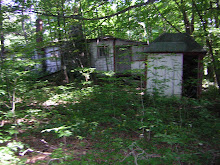The first official day of Spring. It's 82 and humid at the edge of the swamp. Bugs are swarming up in front of my eyes; I'm not entirely sure what I'm trying to see through them.
This swamp has been gone over with a fine comb already. It's been dredged, searched with divers, finally drained, re-scoured, and refilled. The small parking area across the way was where they found the truck. It belonged to a local firefighter and mother of two. Her bag was found separately, along a canal I'll visit later in the day.
All of a sudden, it feels like such a long winter.
Included in the police file on this case is a diary that the missing firefighter's daughter was working on for a 6th grade class project at the time. There are no real clues in it, just a series of heart-wrenching entries.
"Today is my mom's birthday, I wish she was here so we could celebrate. She was turning 33 years old. We all miss her."
To an extent, the last dozen or so years have all been a bit like this. Since Christmas it's been like this at a nonstop, frantic pace. For months now, by far the least uncomfortable part of my week is asking clowns why they think people are so scared of them. That's the easy stuff [in fact we're still finding ways to laugh about that, clowns and I].
In the last few days, I interviewed 3 different clowns... in between visiting the former home of a vampire rapist, recording a bizarre but sincere account of a river monster from a retired engineer, and walking the last known locations of two other missing women. The juxtaposition of jesters may well be what's keeping my mind afloat at this point.
In a variety of ways, missing persons cases are the worst of anything I've become involved in. Worse than religious extremists who pull guns on you, UFO cults who drug your drink (has its moments), worse than conversing with suspected (or convicted) killers, or middle of the night death threats for poking about at Navajo taboos.
"My mom was a good person. There was no reason to hurt her. My brother, dad, and I loved my mom so much," reads another diary entry.
This is history that cuts deep- and it doesn't matter, not as much as you'd think, whether it's been 5 weeks or 50 years. The impact on families, on communities, remains acute. The fog of uncertainty and unsettling potentials takes generations to clear.
The accumulation of unknowables takes a psychological toll on even the most dogged researchers, as does the intense personalization of the work, as strangers become familiar almost as though one's own lost loved ones. Each case becomes a face, faces that become most vivid in late sleepless hours.
It's not just these mysteries in isolation that have worn the edges ragged, it's all mixed in with the whole menagerie of [natural and unnatural] occurrences that have swirled together, and boiled into this gray soup of maddening speculation and omni-directional agnosticism.
All this mucking about in the secret and the deceptive and the unsavory is either an unprofitable business or an expensive hobby, I can't decide which; a steep karmic trade to make, considering the brick wall statistical reality stacked up against any real break-through in knowledge... and the sobering, repeated realization that even if you get to a point of nearly certain mystery-solving, you may never be able to prove that which you have come to know.
Sure, there have been wins in The Digging, some small victories, some times that someone's life was made marginally better by the unrelenting hunt for the story. Mostly even those have seemed secondary, partial, tangenital.
It's rare that the finding out and knowing of the truth, even if helpful, can in any way make up for the unfortunate implications of said truth. At best, you're providing a few more chips for someone to lay down against the roulette wheel of closure.
The darker the story, the colder any comfort in success, and the lonelier the messenger who delivers it.
All of which graduates to approximately the level of abject stupidity, of real idiocy in life choices, when some of the sacrifices made to keep doing the work are also taken into consideration. When enough years go by and enough days pile up without a day off, the math can seem inconceivable, even if I can't quite bring myself to list out and think at once [because if I did my mind might break] about all of the things lost that I can never get back.
Pure stupid, and stupidly necessary. Unshakable. As bleak and intractable and silly as anyone who ever made a royal mess of their life for something that could be cooked in a spoon.
It's a bitter pill, this perpetual striving to accept that all of the same things that keep me up at night also are what gets me up in the morning.
...and as I look at this now, just a matter of weeks after first recording the thoughts, it is with the amused bewilderment that one reflects on one's self as a child. "Ah, yes," it says, half-admiring-half-scorning the optimistic naivete of that self, "that was just before things really got rough."




